Research on Ethical Business Sustainability in East Africa Project
VerifiedAdded on 2023/06/15
|58
|14902
|329
Project
AI Summary
This project proposal outlines an analytical research project focused on the sustainability of ethical business practices in East Africa, with a specific case study on Kamuli Sugar Limited in Uganda. The research aims to examine the level and impact of corruption on businesses and society in the region, assess government policies to combat corruption, and investigate the possibility of promoting ethical practices within SMEs. The study employs both quantitative (survey questionnaires) and qualitative (manager interviews) research methods to gather data and analyze the challenges and opportunities for fostering sustainable and ethical business environments in East Africa. The proposal includes a literature review, methodology, research questions, aims, objectives, and a timeline for the project.
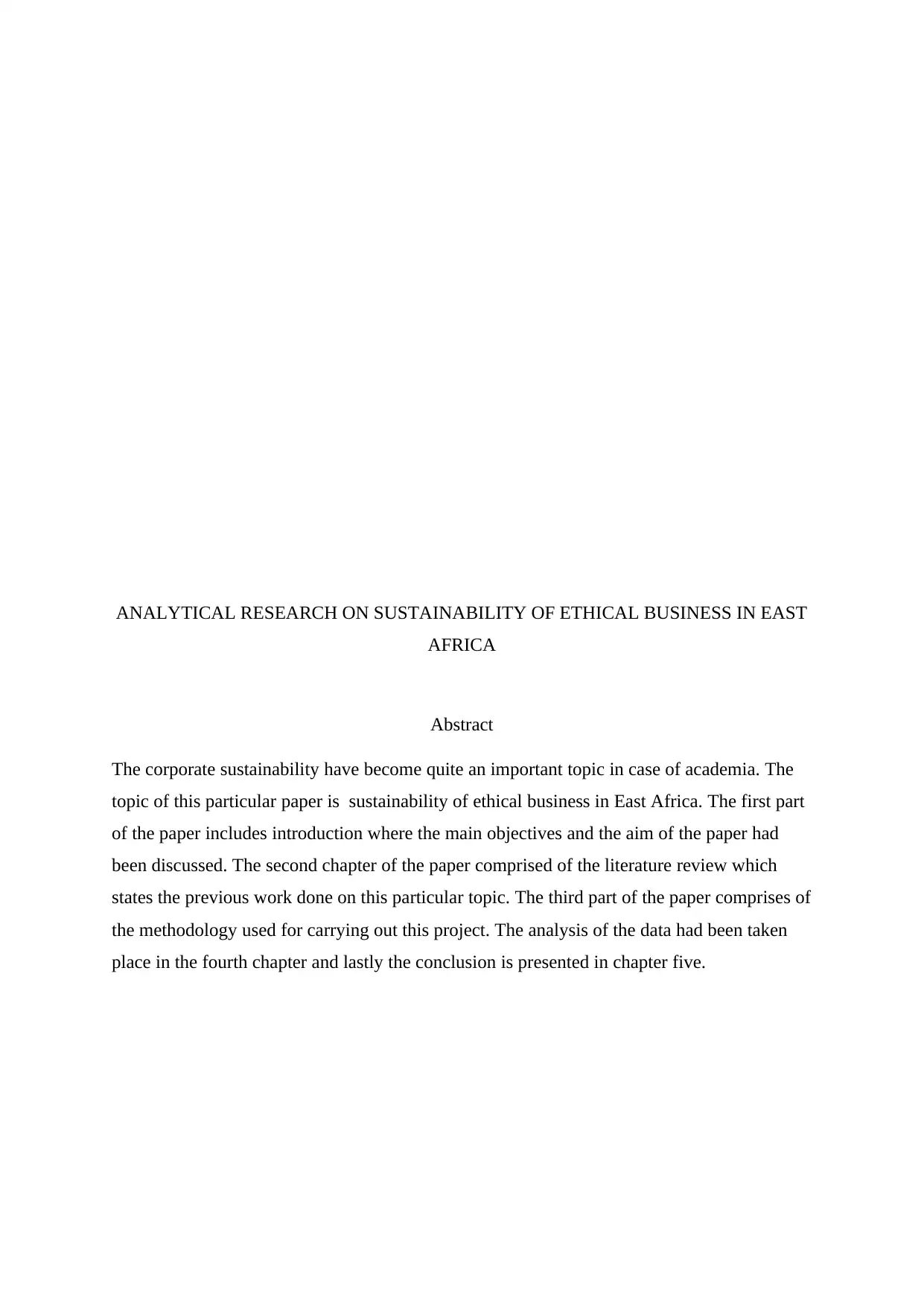
ANALYTICAL RESEARCH ON SUSTAINABILITY OF ETHICAL BUSINESS IN EAST
AFRICA
Abstract
The corporate sustainability have become quite an important topic in case of academia. The
topic of this particular paper is sustainability of ethical business in East Africa. The first part
of the paper includes introduction where the main objectives and the aim of the paper had
been discussed. The second chapter of the paper comprised of the literature review which
states the previous work done on this particular topic. The third part of the paper comprises of
the methodology used for carrying out this project. The analysis of the data had been taken
place in the fourth chapter and lastly the conclusion is presented in chapter five.
AFRICA
Abstract
The corporate sustainability have become quite an important topic in case of academia. The
topic of this particular paper is sustainability of ethical business in East Africa. The first part
of the paper includes introduction where the main objectives and the aim of the paper had
been discussed. The second chapter of the paper comprised of the literature review which
states the previous work done on this particular topic. The third part of the paper comprises of
the methodology used for carrying out this project. The analysis of the data had been taken
place in the fourth chapter and lastly the conclusion is presented in chapter five.
Paraphrase This Document
Need a fresh take? Get an instant paraphrase of this document with our AI Paraphraser
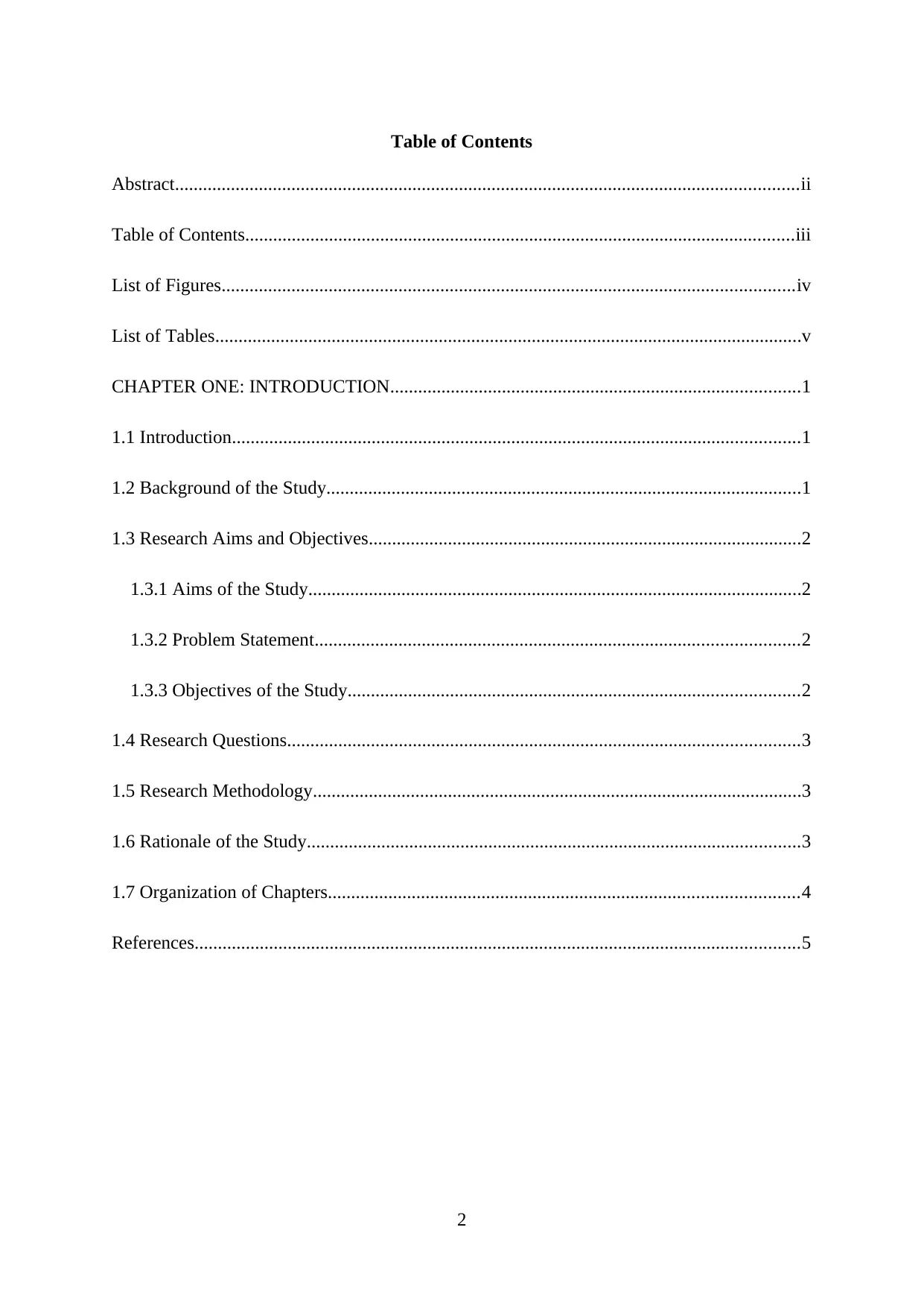
Table of Contents
Abstract......................................................................................................................................ii
Table of Contents......................................................................................................................iii
List of Figures...........................................................................................................................iv
List of Tables..............................................................................................................................v
CHAPTER ONE: INTRODUCTION........................................................................................1
1.1 Introduction..........................................................................................................................1
1.2 Background of the Study......................................................................................................1
1.3 Research Aims and Objectives.............................................................................................2
1.3.1 Aims of the Study..........................................................................................................2
1.3.2 Problem Statement........................................................................................................2
1.3.3 Objectives of the Study.................................................................................................2
1.4 Research Questions..............................................................................................................3
1.5 Research Methodology.........................................................................................................3
1.6 Rationale of the Study..........................................................................................................3
1.7 Organization of Chapters.....................................................................................................4
References..................................................................................................................................5
2
Abstract......................................................................................................................................ii
Table of Contents......................................................................................................................iii
List of Figures...........................................................................................................................iv
List of Tables..............................................................................................................................v
CHAPTER ONE: INTRODUCTION........................................................................................1
1.1 Introduction..........................................................................................................................1
1.2 Background of the Study......................................................................................................1
1.3 Research Aims and Objectives.............................................................................................2
1.3.1 Aims of the Study..........................................................................................................2
1.3.2 Problem Statement........................................................................................................2
1.3.3 Objectives of the Study.................................................................................................2
1.4 Research Questions..............................................................................................................3
1.5 Research Methodology.........................................................................................................3
1.6 Rationale of the Study..........................................................................................................3
1.7 Organization of Chapters.....................................................................................................4
References..................................................................................................................................5
2
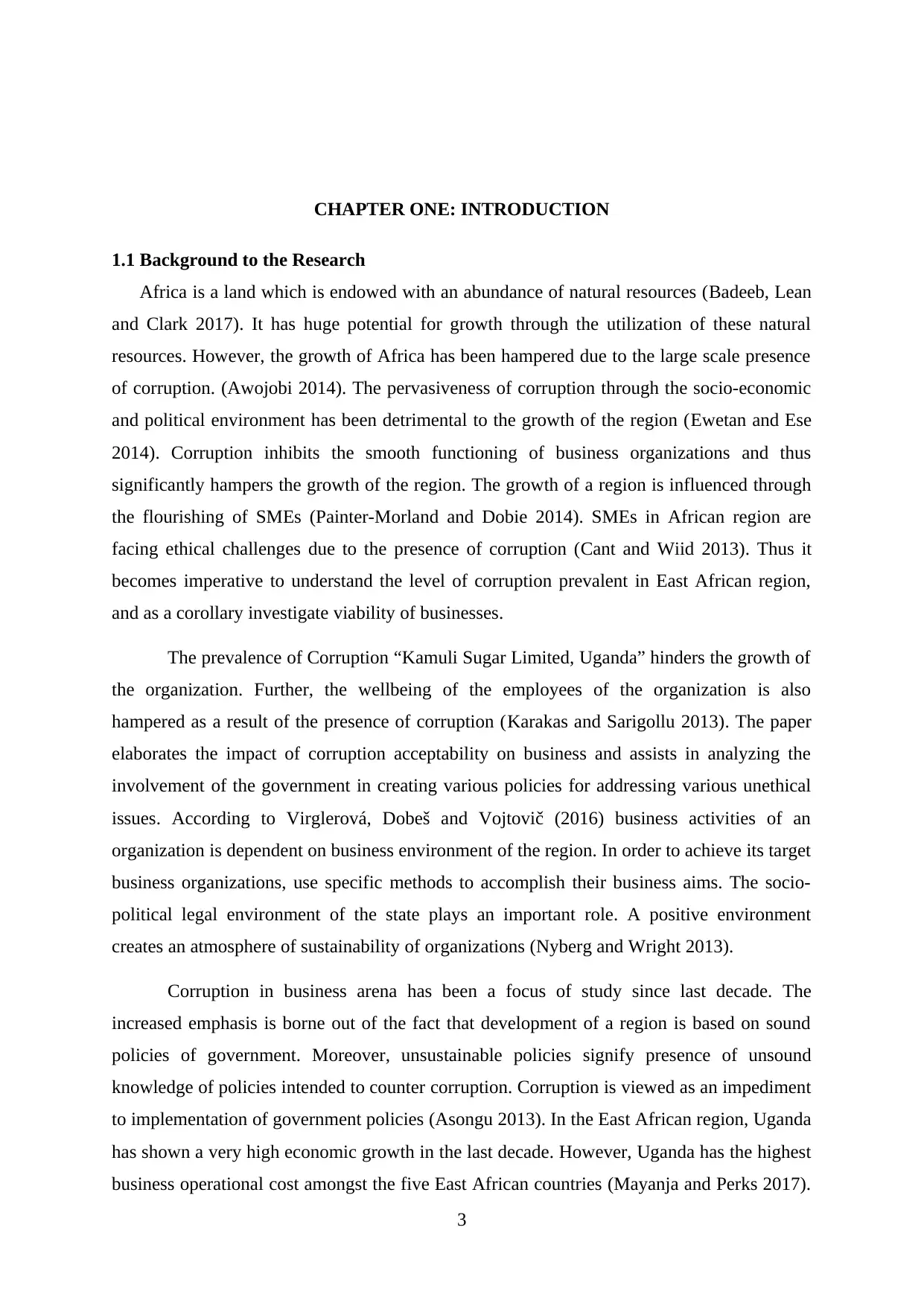
CHAPTER ONE: INTRODUCTION
1.1 Background to the Research
Africa is a land which is endowed with an abundance of natural resources (Badeeb, Lean
and Clark 2017). It has huge potential for growth through the utilization of these natural
resources. However, the growth of Africa has been hampered due to the large scale presence
of corruption. (Awojobi 2014). The pervasiveness of corruption through the socio-economic
and political environment has been detrimental to the growth of the region (Ewetan and Ese
2014). Corruption inhibits the smooth functioning of business organizations and thus
significantly hampers the growth of the region. The growth of a region is influenced through
the flourishing of SMEs (Painter-Morland and Dobie 2014). SMEs in African region are
facing ethical challenges due to the presence of corruption (Cant and Wiid 2013). Thus it
becomes imperative to understand the level of corruption prevalent in East African region,
and as a corollary investigate viability of businesses.
The prevalence of Corruption “Kamuli Sugar Limited, Uganda” hinders the growth of
the organization. Further, the wellbeing of the employees of the organization is also
hampered as a result of the presence of corruption (Karakas and Sarigollu 2013). The paper
elaborates the impact of corruption acceptability on business and assists in analyzing the
involvement of the government in creating various policies for addressing various unethical
issues. According to Virglerová, Dobeš and Vojtovič (2016) business activities of an
organization is dependent on business environment of the region. In order to achieve its target
business organizations, use specific methods to accomplish their business aims. The socio-
political legal environment of the state plays an important role. A positive environment
creates an atmosphere of sustainability of organizations (Nyberg and Wright 2013).
Corruption in business arena has been a focus of study since last decade. The
increased emphasis is borne out of the fact that development of a region is based on sound
policies of government. Moreover, unsustainable policies signify presence of unsound
knowledge of policies intended to counter corruption. Corruption is viewed as an impediment
to implementation of government policies (Asongu 2013). In the East African region, Uganda
has shown a very high economic growth in the last decade. However, Uganda has the highest
business operational cost amongst the five East African countries (Mayanja and Perks 2017).
3
1.1 Background to the Research
Africa is a land which is endowed with an abundance of natural resources (Badeeb, Lean
and Clark 2017). It has huge potential for growth through the utilization of these natural
resources. However, the growth of Africa has been hampered due to the large scale presence
of corruption. (Awojobi 2014). The pervasiveness of corruption through the socio-economic
and political environment has been detrimental to the growth of the region (Ewetan and Ese
2014). Corruption inhibits the smooth functioning of business organizations and thus
significantly hampers the growth of the region. The growth of a region is influenced through
the flourishing of SMEs (Painter-Morland and Dobie 2014). SMEs in African region are
facing ethical challenges due to the presence of corruption (Cant and Wiid 2013). Thus it
becomes imperative to understand the level of corruption prevalent in East African region,
and as a corollary investigate viability of businesses.
The prevalence of Corruption “Kamuli Sugar Limited, Uganda” hinders the growth of
the organization. Further, the wellbeing of the employees of the organization is also
hampered as a result of the presence of corruption (Karakas and Sarigollu 2013). The paper
elaborates the impact of corruption acceptability on business and assists in analyzing the
involvement of the government in creating various policies for addressing various unethical
issues. According to Virglerová, Dobeš and Vojtovič (2016) business activities of an
organization is dependent on business environment of the region. In order to achieve its target
business organizations, use specific methods to accomplish their business aims. The socio-
political legal environment of the state plays an important role. A positive environment
creates an atmosphere of sustainability of organizations (Nyberg and Wright 2013).
Corruption in business arena has been a focus of study since last decade. The
increased emphasis is borne out of the fact that development of a region is based on sound
policies of government. Moreover, unsustainable policies signify presence of unsound
knowledge of policies intended to counter corruption. Corruption is viewed as an impediment
to implementation of government policies (Asongu 2013). In the East African region, Uganda
has shown a very high economic growth in the last decade. However, Uganda has the highest
business operational cost amongst the five East African countries (Mayanja and Perks 2017).
3
⊘ This is a preview!⊘
Do you want full access?
Subscribe today to unlock all pages.

Trusted by 1+ million students worldwide
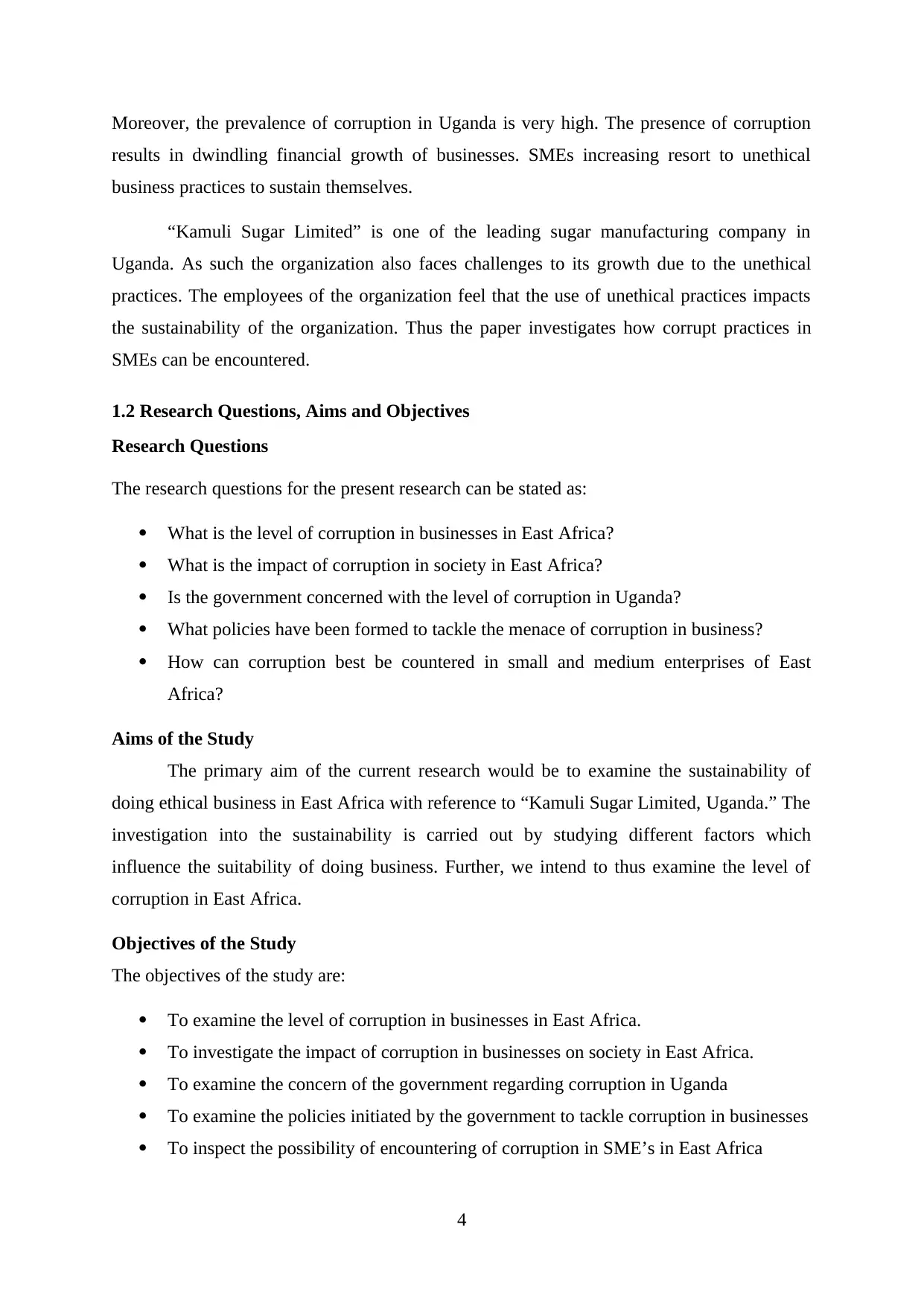
Moreover, the prevalence of corruption in Uganda is very high. The presence of corruption
results in dwindling financial growth of businesses. SMEs increasing resort to unethical
business practices to sustain themselves.
“Kamuli Sugar Limited” is one of the leading sugar manufacturing company in
Uganda. As such the organization also faces challenges to its growth due to the unethical
practices. The employees of the organization feel that the use of unethical practices impacts
the sustainability of the organization. Thus the paper investigates how corrupt practices in
SMEs can be encountered.
1.2 Research Questions, Aims and Objectives
Research Questions
The research questions for the present research can be stated as:
What is the level of corruption in businesses in East Africa?
What is the impact of corruption in society in East Africa?
Is the government concerned with the level of corruption in Uganda?
What policies have been formed to tackle the menace of corruption in business?
How can corruption best be countered in small and medium enterprises of East
Africa?
Aims of the Study
The primary aim of the current research would be to examine the sustainability of
doing ethical business in East Africa with reference to “Kamuli Sugar Limited, Uganda.” The
investigation into the sustainability is carried out by studying different factors which
influence the suitability of doing business. Further, we intend to thus examine the level of
corruption in East Africa.
Objectives of the Study
The objectives of the study are:
To examine the level of corruption in businesses in East Africa.
To investigate the impact of corruption in businesses on society in East Africa.
To examine the concern of the government regarding corruption in Uganda
To examine the policies initiated by the government to tackle corruption in businesses
To inspect the possibility of encountering of corruption in SME’s in East Africa
4
results in dwindling financial growth of businesses. SMEs increasing resort to unethical
business practices to sustain themselves.
“Kamuli Sugar Limited” is one of the leading sugar manufacturing company in
Uganda. As such the organization also faces challenges to its growth due to the unethical
practices. The employees of the organization feel that the use of unethical practices impacts
the sustainability of the organization. Thus the paper investigates how corrupt practices in
SMEs can be encountered.
1.2 Research Questions, Aims and Objectives
Research Questions
The research questions for the present research can be stated as:
What is the level of corruption in businesses in East Africa?
What is the impact of corruption in society in East Africa?
Is the government concerned with the level of corruption in Uganda?
What policies have been formed to tackle the menace of corruption in business?
How can corruption best be countered in small and medium enterprises of East
Africa?
Aims of the Study
The primary aim of the current research would be to examine the sustainability of
doing ethical business in East Africa with reference to “Kamuli Sugar Limited, Uganda.” The
investigation into the sustainability is carried out by studying different factors which
influence the suitability of doing business. Further, we intend to thus examine the level of
corruption in East Africa.
Objectives of the Study
The objectives of the study are:
To examine the level of corruption in businesses in East Africa.
To investigate the impact of corruption in businesses on society in East Africa.
To examine the concern of the government regarding corruption in Uganda
To examine the policies initiated by the government to tackle corruption in businesses
To inspect the possibility of encountering of corruption in SME’s in East Africa
4
Paraphrase This Document
Need a fresh take? Get an instant paraphrase of this document with our AI Paraphraser
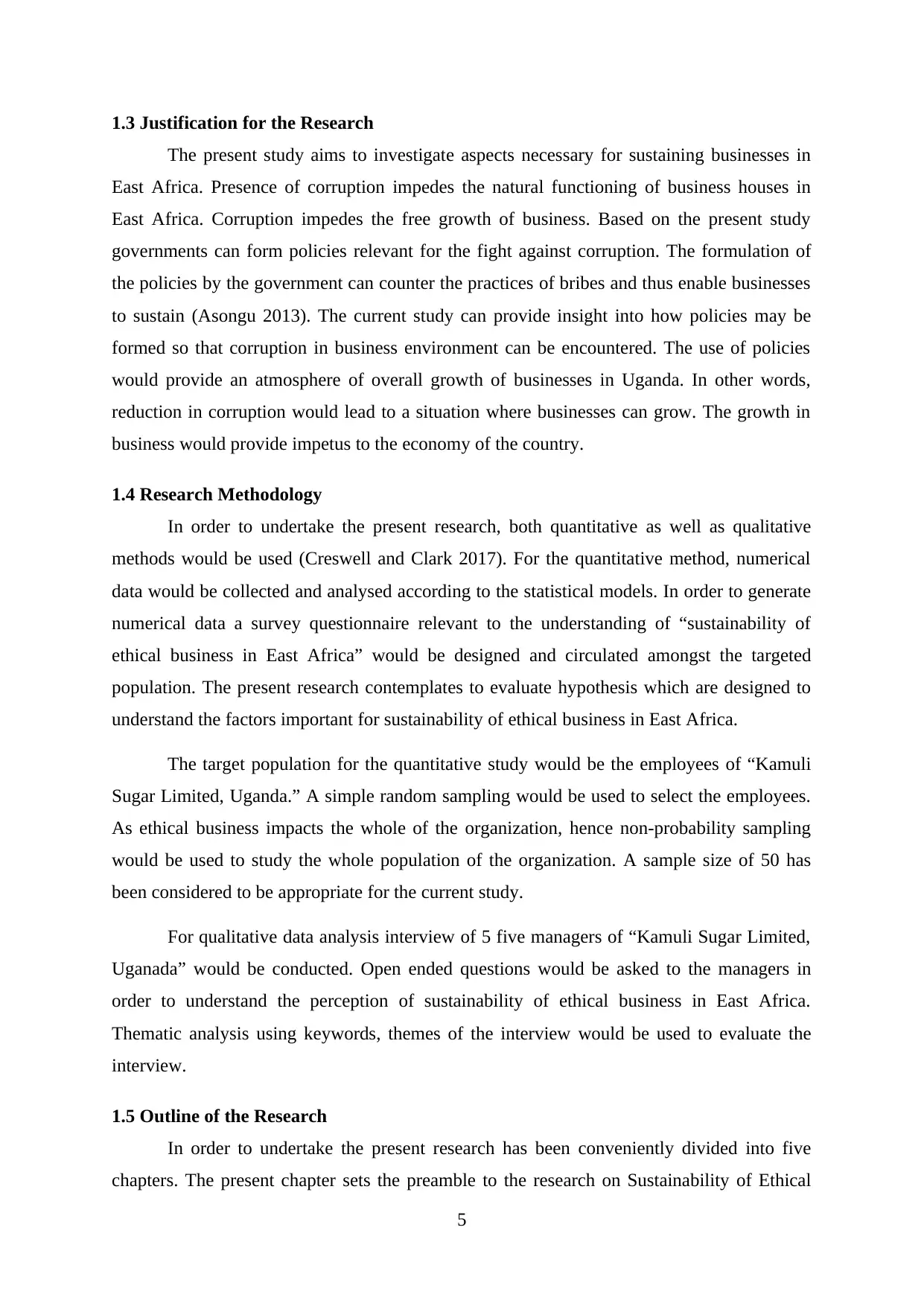
1.3 Justification for the Research
The present study aims to investigate aspects necessary for sustaining businesses in
East Africa. Presence of corruption impedes the natural functioning of business houses in
East Africa. Corruption impedes the free growth of business. Based on the present study
governments can form policies relevant for the fight against corruption. The formulation of
the policies by the government can counter the practices of bribes and thus enable businesses
to sustain (Asongu 2013). The current study can provide insight into how policies may be
formed so that corruption in business environment can be encountered. The use of policies
would provide an atmosphere of overall growth of businesses in Uganda. In other words,
reduction in corruption would lead to a situation where businesses can grow. The growth in
business would provide impetus to the economy of the country.
1.4 Research Methodology
In order to undertake the present research, both quantitative as well as qualitative
methods would be used (Creswell and Clark 2017). For the quantitative method, numerical
data would be collected and analysed according to the statistical models. In order to generate
numerical data a survey questionnaire relevant to the understanding of “sustainability of
ethical business in East Africa” would be designed and circulated amongst the targeted
population. The present research contemplates to evaluate hypothesis which are designed to
understand the factors important for sustainability of ethical business in East Africa.
The target population for the quantitative study would be the employees of “Kamuli
Sugar Limited, Uganda.” A simple random sampling would be used to select the employees.
As ethical business impacts the whole of the organization, hence non-probability sampling
would be used to study the whole population of the organization. A sample size of 50 has
been considered to be appropriate for the current study.
For qualitative data analysis interview of 5 five managers of “Kamuli Sugar Limited,
Uganada” would be conducted. Open ended questions would be asked to the managers in
order to understand the perception of sustainability of ethical business in East Africa.
Thematic analysis using keywords, themes of the interview would be used to evaluate the
interview.
1.5 Outline of the Research
In order to undertake the present research has been conveniently divided into five
chapters. The present chapter sets the preamble to the research on Sustainability of Ethical
5
The present study aims to investigate aspects necessary for sustaining businesses in
East Africa. Presence of corruption impedes the natural functioning of business houses in
East Africa. Corruption impedes the free growth of business. Based on the present study
governments can form policies relevant for the fight against corruption. The formulation of
the policies by the government can counter the practices of bribes and thus enable businesses
to sustain (Asongu 2013). The current study can provide insight into how policies may be
formed so that corruption in business environment can be encountered. The use of policies
would provide an atmosphere of overall growth of businesses in Uganda. In other words,
reduction in corruption would lead to a situation where businesses can grow. The growth in
business would provide impetus to the economy of the country.
1.4 Research Methodology
In order to undertake the present research, both quantitative as well as qualitative
methods would be used (Creswell and Clark 2017). For the quantitative method, numerical
data would be collected and analysed according to the statistical models. In order to generate
numerical data a survey questionnaire relevant to the understanding of “sustainability of
ethical business in East Africa” would be designed and circulated amongst the targeted
population. The present research contemplates to evaluate hypothesis which are designed to
understand the factors important for sustainability of ethical business in East Africa.
The target population for the quantitative study would be the employees of “Kamuli
Sugar Limited, Uganda.” A simple random sampling would be used to select the employees.
As ethical business impacts the whole of the organization, hence non-probability sampling
would be used to study the whole population of the organization. A sample size of 50 has
been considered to be appropriate for the current study.
For qualitative data analysis interview of 5 five managers of “Kamuli Sugar Limited,
Uganada” would be conducted. Open ended questions would be asked to the managers in
order to understand the perception of sustainability of ethical business in East Africa.
Thematic analysis using keywords, themes of the interview would be used to evaluate the
interview.
1.5 Outline of the Research
In order to undertake the present research has been conveniently divided into five
chapters. The present chapter sets the preamble to the research on Sustainability of Ethical
5
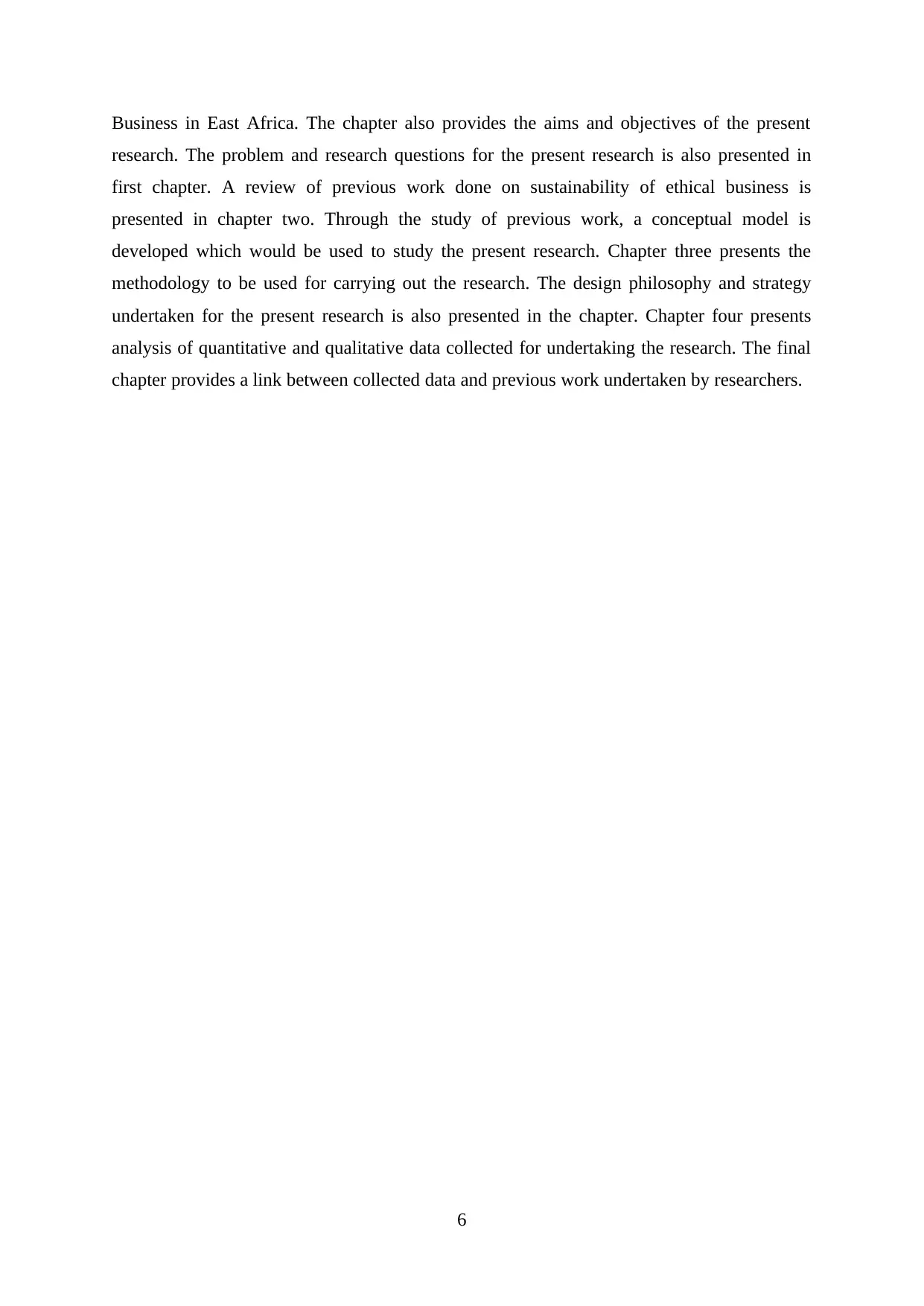
Business in East Africa. The chapter also provides the aims and objectives of the present
research. The problem and research questions for the present research is also presented in
first chapter. A review of previous work done on sustainability of ethical business is
presented in chapter two. Through the study of previous work, a conceptual model is
developed which would be used to study the present research. Chapter three presents the
methodology to be used for carrying out the research. The design philosophy and strategy
undertaken for the present research is also presented in the chapter. Chapter four presents
analysis of quantitative and qualitative data collected for undertaking the research. The final
chapter provides a link between collected data and previous work undertaken by researchers.
6
research. The problem and research questions for the present research is also presented in
first chapter. A review of previous work done on sustainability of ethical business is
presented in chapter two. Through the study of previous work, a conceptual model is
developed which would be used to study the present research. Chapter three presents the
methodology to be used for carrying out the research. The design philosophy and strategy
undertaken for the present research is also presented in the chapter. Chapter four presents
analysis of quantitative and qualitative data collected for undertaking the research. The final
chapter provides a link between collected data and previous work undertaken by researchers.
6
⊘ This is a preview!⊘
Do you want full access?
Subscribe today to unlock all pages.

Trusted by 1+ million students worldwide
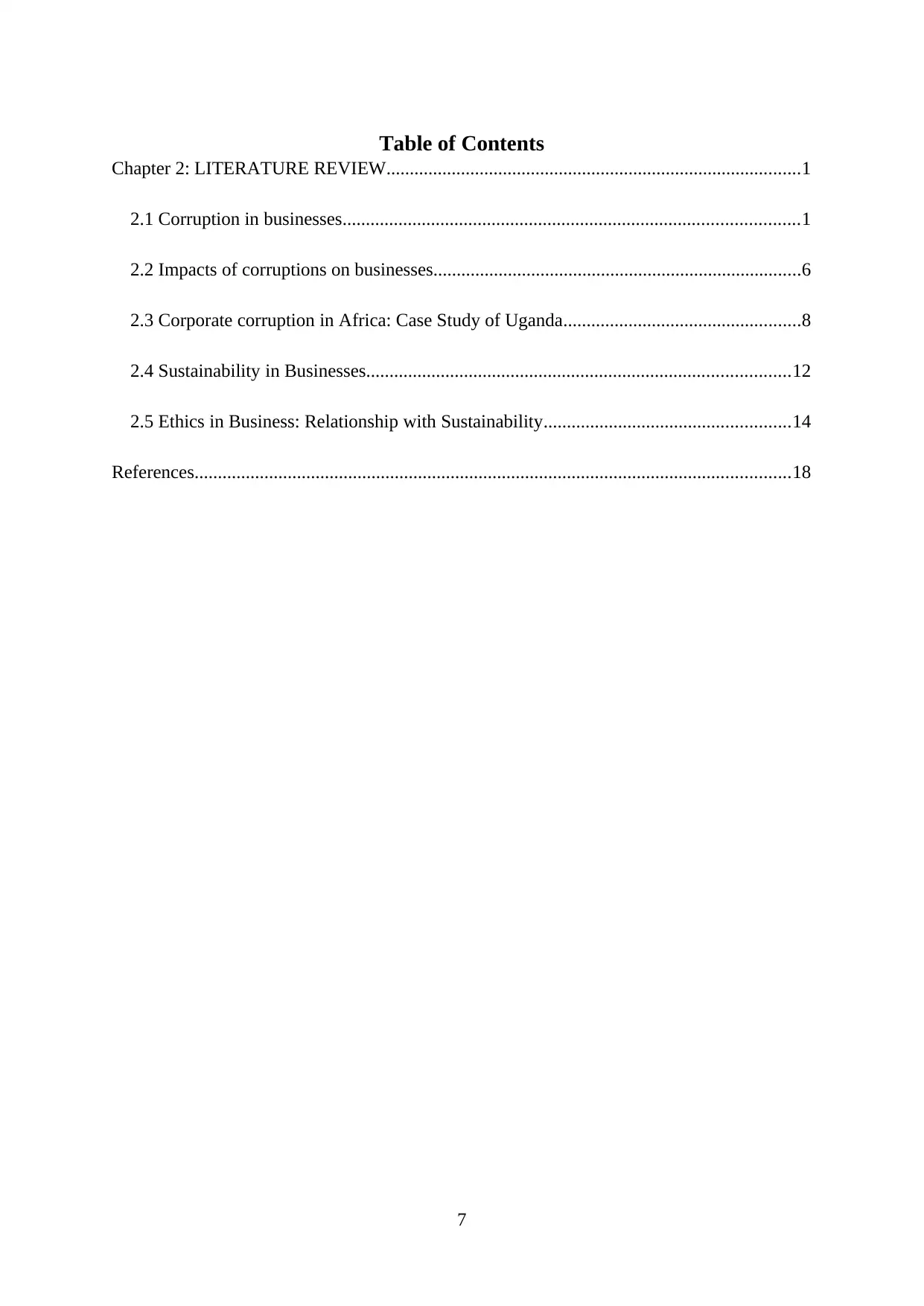
Table of Contents
Chapter 2: LITERATURE REVIEW.........................................................................................1
2.1 Corruption in businesses..................................................................................................1
2.2 Impacts of corruptions on businesses...............................................................................6
2.3 Corporate corruption in Africa: Case Study of Uganda...................................................8
2.4 Sustainability in Businesses...........................................................................................12
2.5 Ethics in Business: Relationship with Sustainability.....................................................14
References................................................................................................................................18
7
Chapter 2: LITERATURE REVIEW.........................................................................................1
2.1 Corruption in businesses..................................................................................................1
2.2 Impacts of corruptions on businesses...............................................................................6
2.3 Corporate corruption in Africa: Case Study of Uganda...................................................8
2.4 Sustainability in Businesses...........................................................................................12
2.5 Ethics in Business: Relationship with Sustainability.....................................................14
References................................................................................................................................18
7
Paraphrase This Document
Need a fresh take? Get an instant paraphrase of this document with our AI Paraphraser
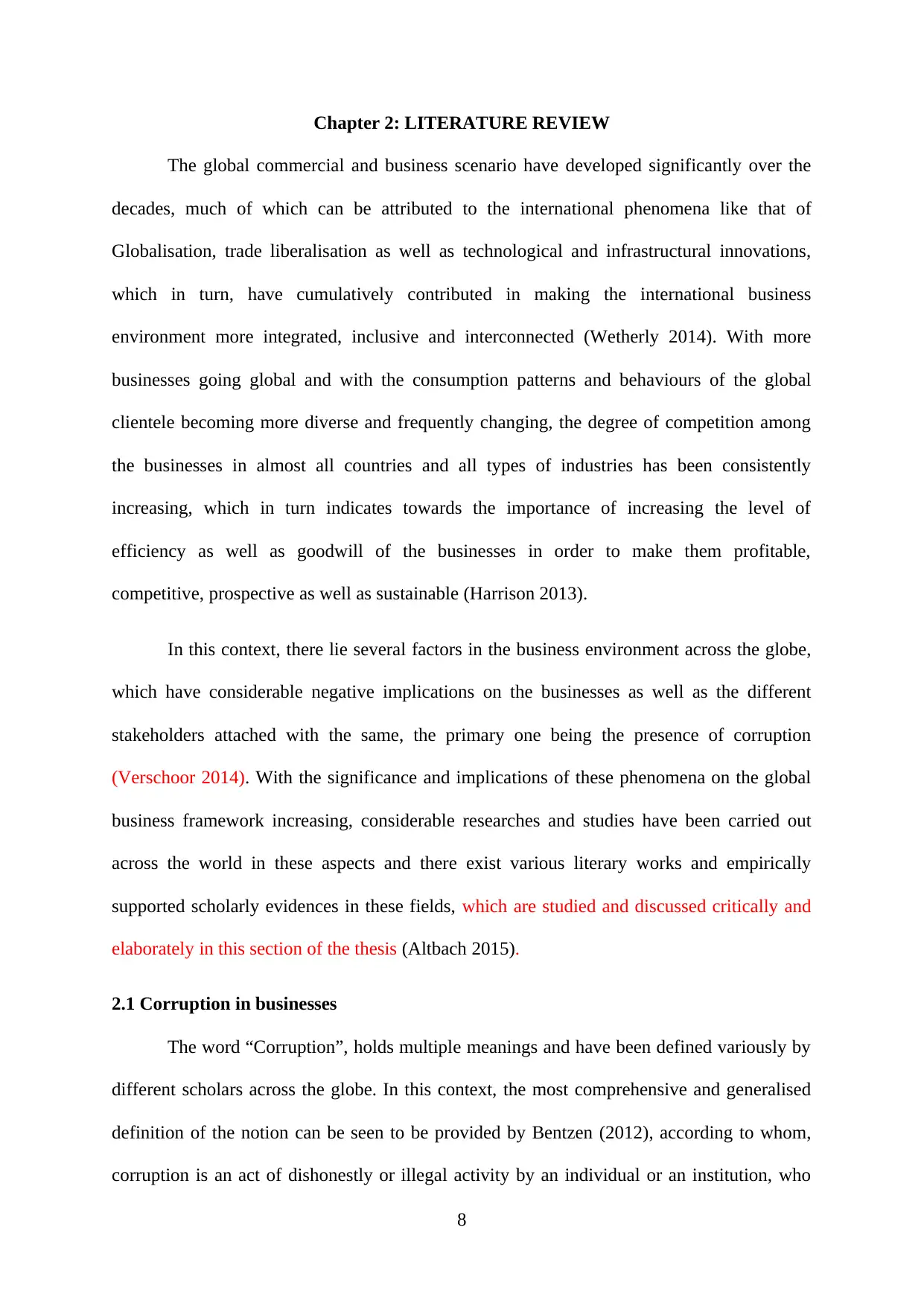
Chapter 2: LITERATURE REVIEW
The global commercial and business scenario have developed significantly over the
decades, much of which can be attributed to the international phenomena like that of
Globalisation, trade liberalisation as well as technological and infrastructural innovations,
which in turn, have cumulatively contributed in making the international business
environment more integrated, inclusive and interconnected (Wetherly 2014). With more
businesses going global and with the consumption patterns and behaviours of the global
clientele becoming more diverse and frequently changing, the degree of competition among
the businesses in almost all countries and all types of industries has been consistently
increasing, which in turn indicates towards the importance of increasing the level of
efficiency as well as goodwill of the businesses in order to make them profitable,
competitive, prospective as well as sustainable (Harrison 2013).
In this context, there lie several factors in the business environment across the globe,
which have considerable negative implications on the businesses as well as the different
stakeholders attached with the same, the primary one being the presence of corruption
(Verschoor 2014). With the significance and implications of these phenomena on the global
business framework increasing, considerable researches and studies have been carried out
across the world in these aspects and there exist various literary works and empirically
supported scholarly evidences in these fields, which are studied and discussed critically and
elaborately in this section of the thesis (Altbach 2015).
2.1 Corruption in businesses
The word “Corruption”, holds multiple meanings and have been defined variously by
different scholars across the globe. In this context, the most comprehensive and generalised
definition of the notion can be seen to be provided by Bentzen (2012), according to whom,
corruption is an act of dishonestly or illegal activity by an individual or an institution, who
8
The global commercial and business scenario have developed significantly over the
decades, much of which can be attributed to the international phenomena like that of
Globalisation, trade liberalisation as well as technological and infrastructural innovations,
which in turn, have cumulatively contributed in making the international business
environment more integrated, inclusive and interconnected (Wetherly 2014). With more
businesses going global and with the consumption patterns and behaviours of the global
clientele becoming more diverse and frequently changing, the degree of competition among
the businesses in almost all countries and all types of industries has been consistently
increasing, which in turn indicates towards the importance of increasing the level of
efficiency as well as goodwill of the businesses in order to make them profitable,
competitive, prospective as well as sustainable (Harrison 2013).
In this context, there lie several factors in the business environment across the globe,
which have considerable negative implications on the businesses as well as the different
stakeholders attached with the same, the primary one being the presence of corruption
(Verschoor 2014). With the significance and implications of these phenomena on the global
business framework increasing, considerable researches and studies have been carried out
across the world in these aspects and there exist various literary works and empirically
supported scholarly evidences in these fields, which are studied and discussed critically and
elaborately in this section of the thesis (Altbach 2015).
2.1 Corruption in businesses
The word “Corruption”, holds multiple meanings and have been defined variously by
different scholars across the globe. In this context, the most comprehensive and generalised
definition of the notion can be seen to be provided by Bentzen (2012), according to whom,
corruption is an act of dishonestly or illegal activity by an individual or an institution, who
8
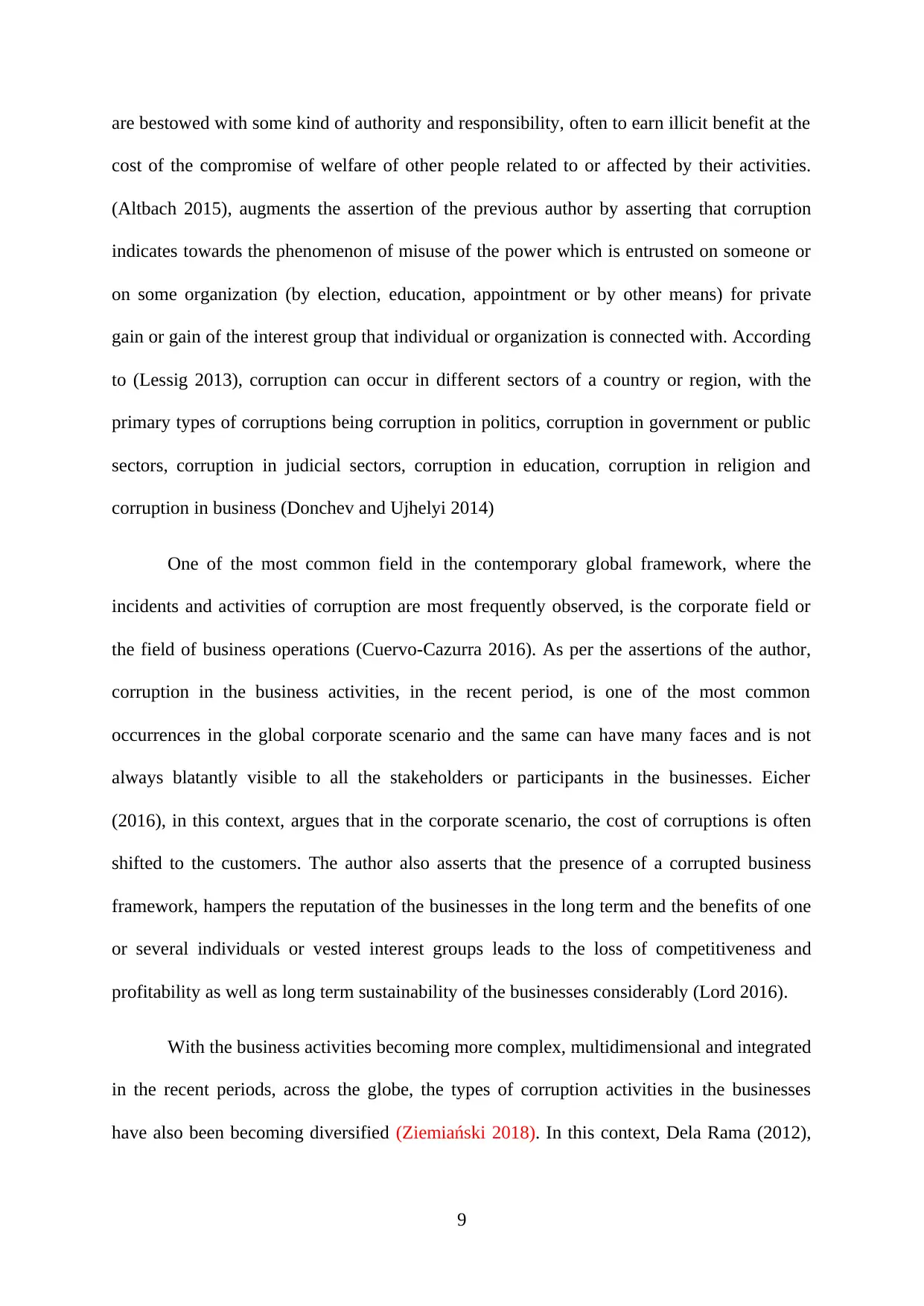
are bestowed with some kind of authority and responsibility, often to earn illicit benefit at the
cost of the compromise of welfare of other people related to or affected by their activities.
(Altbach 2015), augments the assertion of the previous author by asserting that corruption
indicates towards the phenomenon of misuse of the power which is entrusted on someone or
on some organization (by election, education, appointment or by other means) for private
gain or gain of the interest group that individual or organization is connected with. According
to (Lessig 2013), corruption can occur in different sectors of a country or region, with the
primary types of corruptions being corruption in politics, corruption in government or public
sectors, corruption in judicial sectors, corruption in education, corruption in religion and
corruption in business (Donchev and Ujhelyi 2014)
One of the most common field in the contemporary global framework, where the
incidents and activities of corruption are most frequently observed, is the corporate field or
the field of business operations (Cuervo-Cazurra 2016). As per the assertions of the author,
corruption in the business activities, in the recent period, is one of the most common
occurrences in the global corporate scenario and the same can have many faces and is not
always blatantly visible to all the stakeholders or participants in the businesses. Eicher
(2016), in this context, argues that in the corporate scenario, the cost of corruptions is often
shifted to the customers. The author also asserts that the presence of a corrupted business
framework, hampers the reputation of the businesses in the long term and the benefits of one
or several individuals or vested interest groups leads to the loss of competitiveness and
profitability as well as long term sustainability of the businesses considerably (Lord 2016).
With the business activities becoming more complex, multidimensional and integrated
in the recent periods, across the globe, the types of corruption activities in the businesses
have also been becoming diversified (Ziemiański 2018). In this context, Dela Rama (2012),
9
cost of the compromise of welfare of other people related to or affected by their activities.
(Altbach 2015), augments the assertion of the previous author by asserting that corruption
indicates towards the phenomenon of misuse of the power which is entrusted on someone or
on some organization (by election, education, appointment or by other means) for private
gain or gain of the interest group that individual or organization is connected with. According
to (Lessig 2013), corruption can occur in different sectors of a country or region, with the
primary types of corruptions being corruption in politics, corruption in government or public
sectors, corruption in judicial sectors, corruption in education, corruption in religion and
corruption in business (Donchev and Ujhelyi 2014)
One of the most common field in the contemporary global framework, where the
incidents and activities of corruption are most frequently observed, is the corporate field or
the field of business operations (Cuervo-Cazurra 2016). As per the assertions of the author,
corruption in the business activities, in the recent period, is one of the most common
occurrences in the global corporate scenario and the same can have many faces and is not
always blatantly visible to all the stakeholders or participants in the businesses. Eicher
(2016), in this context, argues that in the corporate scenario, the cost of corruptions is often
shifted to the customers. The author also asserts that the presence of a corrupted business
framework, hampers the reputation of the businesses in the long term and the benefits of one
or several individuals or vested interest groups leads to the loss of competitiveness and
profitability as well as long term sustainability of the businesses considerably (Lord 2016).
With the business activities becoming more complex, multidimensional and integrated
in the recent periods, across the globe, the types of corruption activities in the businesses
have also been becoming diversified (Ziemiański 2018). In this context, Dela Rama (2012),
9
⊘ This is a preview!⊘
Do you want full access?
Subscribe today to unlock all pages.

Trusted by 1+ million students worldwide
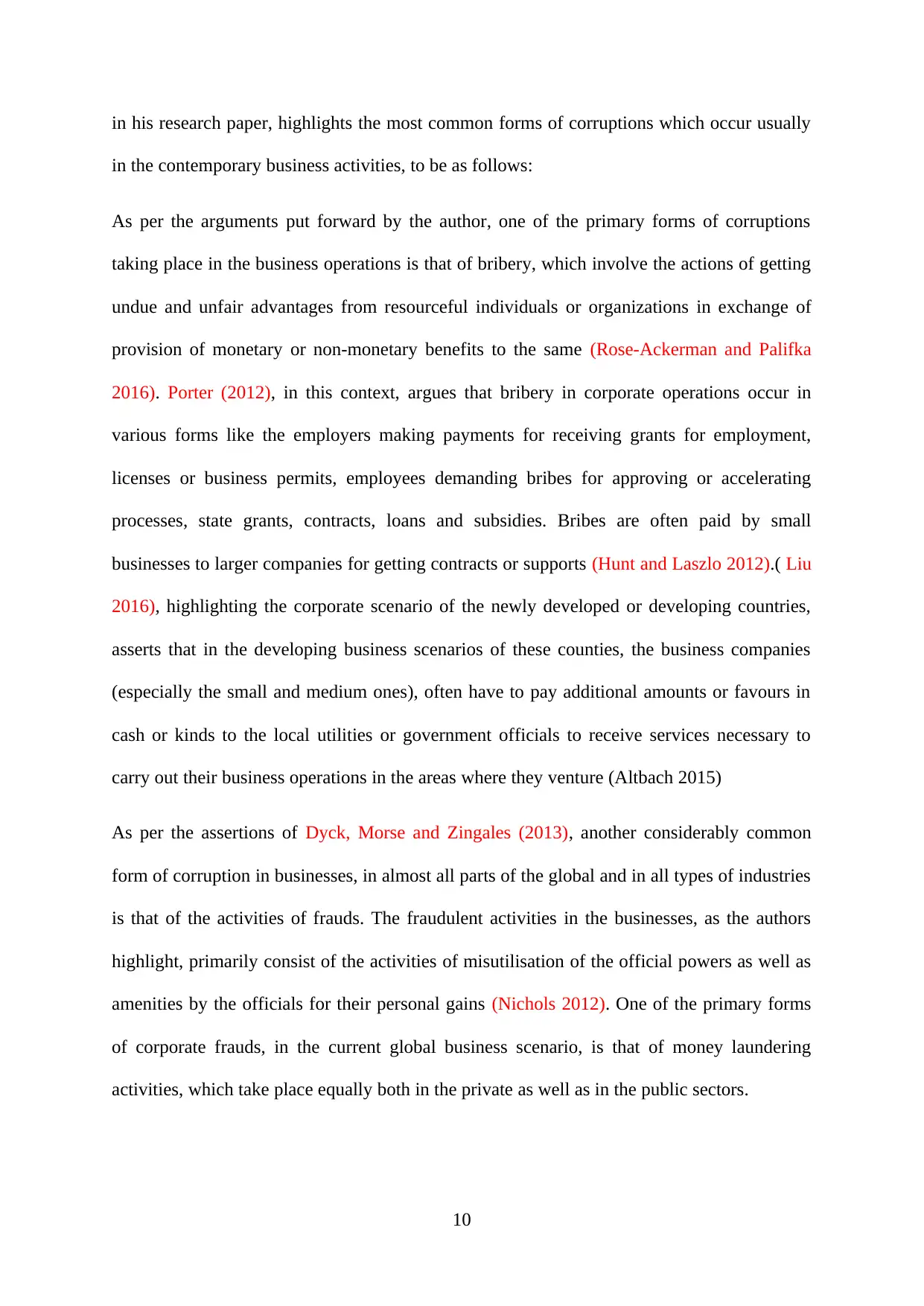
in his research paper, highlights the most common forms of corruptions which occur usually
in the contemporary business activities, to be as follows:
As per the arguments put forward by the author, one of the primary forms of corruptions
taking place in the business operations is that of bribery, which involve the actions of getting
undue and unfair advantages from resourceful individuals or organizations in exchange of
provision of monetary or non-monetary benefits to the same (Rose-Ackerman and Palifka
2016). Porter (2012), in this context, argues that bribery in corporate operations occur in
various forms like the employers making payments for receiving grants for employment,
licenses or business permits, employees demanding bribes for approving or accelerating
processes, state grants, contracts, loans and subsidies. Bribes are often paid by small
businesses to larger companies for getting contracts or supports (Hunt and Laszlo 2012).( Liu
2016), highlighting the corporate scenario of the newly developed or developing countries,
asserts that in the developing business scenarios of these counties, the business companies
(especially the small and medium ones), often have to pay additional amounts or favours in
cash or kinds to the local utilities or government officials to receive services necessary to
carry out their business operations in the areas where they venture (Altbach 2015)
As per the assertions of Dyck, Morse and Zingales (2013), another considerably common
form of corruption in businesses, in almost all parts of the global and in all types of industries
is that of the activities of frauds. The fraudulent activities in the businesses, as the authors
highlight, primarily consist of the activities of misutilisation of the official powers as well as
amenities by the officials for their personal gains (Nichols 2012). One of the primary forms
of corporate frauds, in the current global business scenario, is that of money laundering
activities, which take place equally both in the private as well as in the public sectors.
10
in the contemporary business activities, to be as follows:
As per the arguments put forward by the author, one of the primary forms of corruptions
taking place in the business operations is that of bribery, which involve the actions of getting
undue and unfair advantages from resourceful individuals or organizations in exchange of
provision of monetary or non-monetary benefits to the same (Rose-Ackerman and Palifka
2016). Porter (2012), in this context, argues that bribery in corporate operations occur in
various forms like the employers making payments for receiving grants for employment,
licenses or business permits, employees demanding bribes for approving or accelerating
processes, state grants, contracts, loans and subsidies. Bribes are often paid by small
businesses to larger companies for getting contracts or supports (Hunt and Laszlo 2012).( Liu
2016), highlighting the corporate scenario of the newly developed or developing countries,
asserts that in the developing business scenarios of these counties, the business companies
(especially the small and medium ones), often have to pay additional amounts or favours in
cash or kinds to the local utilities or government officials to receive services necessary to
carry out their business operations in the areas where they venture (Altbach 2015)
As per the assertions of Dyck, Morse and Zingales (2013), another considerably common
form of corruption in businesses, in almost all parts of the global and in all types of industries
is that of the activities of frauds. The fraudulent activities in the businesses, as the authors
highlight, primarily consist of the activities of misutilisation of the official powers as well as
amenities by the officials for their personal gains (Nichols 2012). One of the primary forms
of corporate frauds, in the current global business scenario, is that of money laundering
activities, which take place equally both in the private as well as in the public sectors.
10
Paraphrase This Document
Need a fresh take? Get an instant paraphrase of this document with our AI Paraphraser
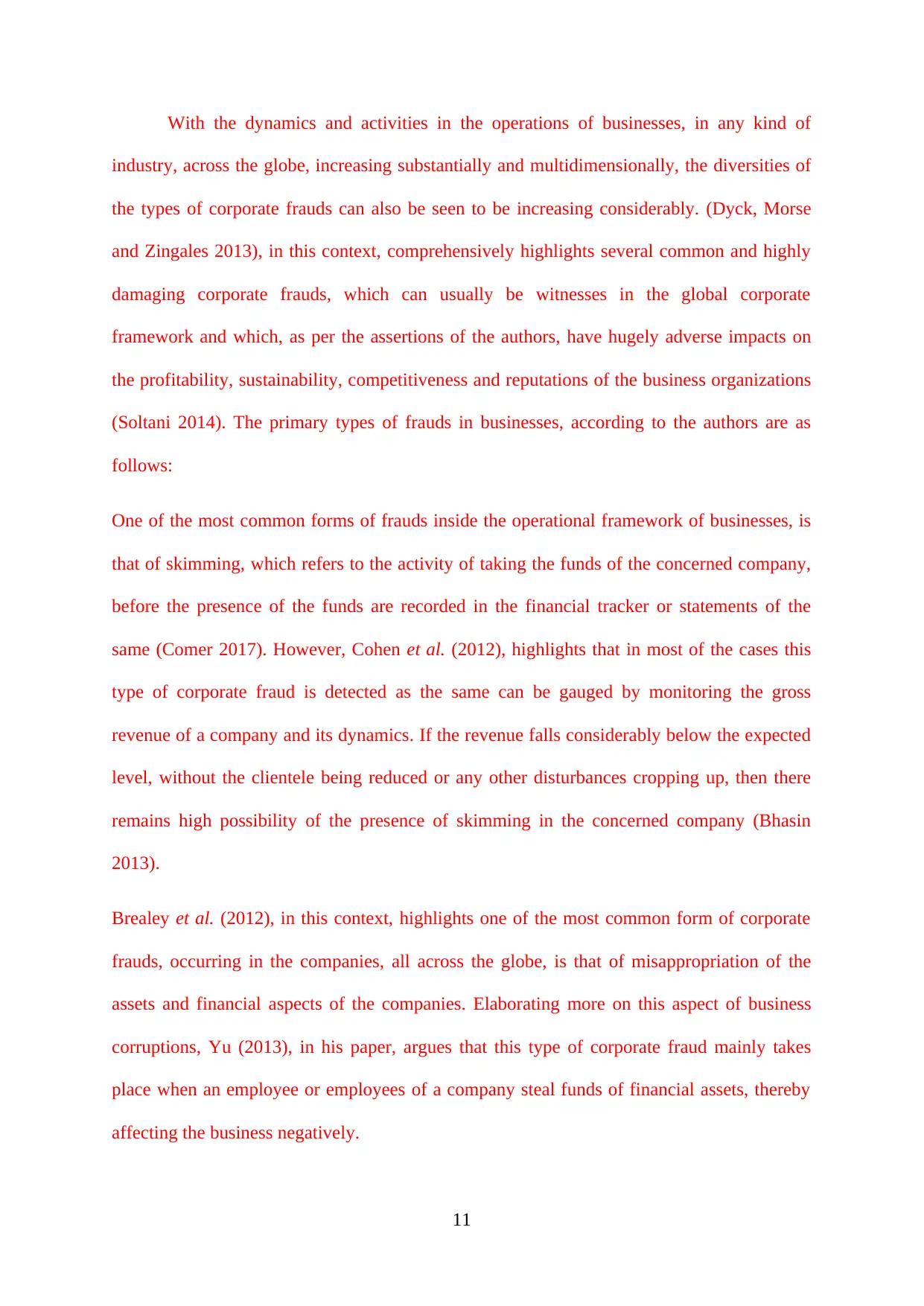
With the dynamics and activities in the operations of businesses, in any kind of
industry, across the globe, increasing substantially and multidimensionally, the diversities of
the types of corporate frauds can also be seen to be increasing considerably. (Dyck, Morse
and Zingales 2013), in this context, comprehensively highlights several common and highly
damaging corporate frauds, which can usually be witnesses in the global corporate
framework and which, as per the assertions of the authors, have hugely adverse impacts on
the profitability, sustainability, competitiveness and reputations of the business organizations
(Soltani 2014). The primary types of frauds in businesses, according to the authors are as
follows:
One of the most common forms of frauds inside the operational framework of businesses, is
that of skimming, which refers to the activity of taking the funds of the concerned company,
before the presence of the funds are recorded in the financial tracker or statements of the
same (Comer 2017). However, Cohen et al. (2012), highlights that in most of the cases this
type of corporate fraud is detected as the same can be gauged by monitoring the gross
revenue of a company and its dynamics. If the revenue falls considerably below the expected
level, without the clientele being reduced or any other disturbances cropping up, then there
remains high possibility of the presence of skimming in the concerned company (Bhasin
2013).
Brealey et al. (2012), in this context, highlights one of the most common form of corporate
frauds, occurring in the companies, all across the globe, is that of misappropriation of the
assets and financial aspects of the companies. Elaborating more on this aspect of business
corruptions, Yu (2013), in his paper, argues that this type of corporate fraud mainly takes
place when an employee or employees of a company steal funds of financial assets, thereby
affecting the business negatively.
11
industry, across the globe, increasing substantially and multidimensionally, the diversities of
the types of corporate frauds can also be seen to be increasing considerably. (Dyck, Morse
and Zingales 2013), in this context, comprehensively highlights several common and highly
damaging corporate frauds, which can usually be witnesses in the global corporate
framework and which, as per the assertions of the authors, have hugely adverse impacts on
the profitability, sustainability, competitiveness and reputations of the business organizations
(Soltani 2014). The primary types of frauds in businesses, according to the authors are as
follows:
One of the most common forms of frauds inside the operational framework of businesses, is
that of skimming, which refers to the activity of taking the funds of the concerned company,
before the presence of the funds are recorded in the financial tracker or statements of the
same (Comer 2017). However, Cohen et al. (2012), highlights that in most of the cases this
type of corporate fraud is detected as the same can be gauged by monitoring the gross
revenue of a company and its dynamics. If the revenue falls considerably below the expected
level, without the clientele being reduced or any other disturbances cropping up, then there
remains high possibility of the presence of skimming in the concerned company (Bhasin
2013).
Brealey et al. (2012), in this context, highlights one of the most common form of corporate
frauds, occurring in the companies, all across the globe, is that of misappropriation of the
assets and financial aspects of the companies. Elaborating more on this aspect of business
corruptions, Yu (2013), in his paper, argues that this type of corporate fraud mainly takes
place when an employee or employees of a company steal funds of financial assets, thereby
affecting the business negatively.
11
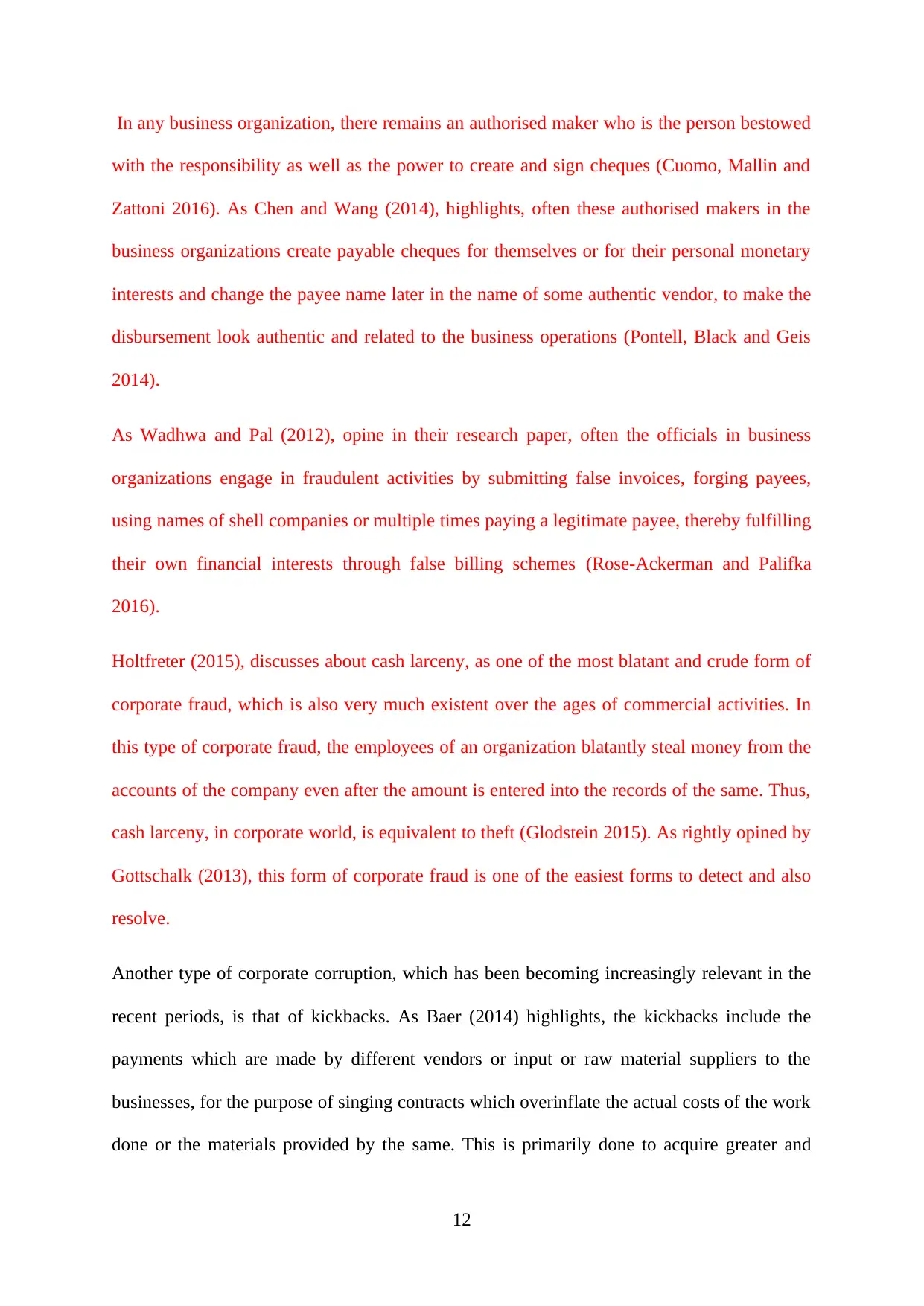
In any business organization, there remains an authorised maker who is the person bestowed
with the responsibility as well as the power to create and sign cheques (Cuomo, Mallin and
Zattoni 2016). As Chen and Wang (2014), highlights, often these authorised makers in the
business organizations create payable cheques for themselves or for their personal monetary
interests and change the payee name later in the name of some authentic vendor, to make the
disbursement look authentic and related to the business operations (Pontell, Black and Geis
2014).
As Wadhwa and Pal (2012), opine in their research paper, often the officials in business
organizations engage in fraudulent activities by submitting false invoices, forging payees,
using names of shell companies or multiple times paying a legitimate payee, thereby fulfilling
their own financial interests through false billing schemes (Rose-Ackerman and Palifka
2016).
Holtfreter (2015), discusses about cash larceny, as one of the most blatant and crude form of
corporate fraud, which is also very much existent over the ages of commercial activities. In
this type of corporate fraud, the employees of an organization blatantly steal money from the
accounts of the company even after the amount is entered into the records of the same. Thus,
cash larceny, in corporate world, is equivalent to theft (Glodstein 2015). As rightly opined by
Gottschalk (2013), this form of corporate fraud is one of the easiest forms to detect and also
resolve.
Another type of corporate corruption, which has been becoming increasingly relevant in the
recent periods, is that of kickbacks. As Baer (2014) highlights, the kickbacks include the
payments which are made by different vendors or input or raw material suppliers to the
businesses, for the purpose of singing contracts which overinflate the actual costs of the work
done or the materials provided by the same. This is primarily done to acquire greater and
12
with the responsibility as well as the power to create and sign cheques (Cuomo, Mallin and
Zattoni 2016). As Chen and Wang (2014), highlights, often these authorised makers in the
business organizations create payable cheques for themselves or for their personal monetary
interests and change the payee name later in the name of some authentic vendor, to make the
disbursement look authentic and related to the business operations (Pontell, Black and Geis
2014).
As Wadhwa and Pal (2012), opine in their research paper, often the officials in business
organizations engage in fraudulent activities by submitting false invoices, forging payees,
using names of shell companies or multiple times paying a legitimate payee, thereby fulfilling
their own financial interests through false billing schemes (Rose-Ackerman and Palifka
2016).
Holtfreter (2015), discusses about cash larceny, as one of the most blatant and crude form of
corporate fraud, which is also very much existent over the ages of commercial activities. In
this type of corporate fraud, the employees of an organization blatantly steal money from the
accounts of the company even after the amount is entered into the records of the same. Thus,
cash larceny, in corporate world, is equivalent to theft (Glodstein 2015). As rightly opined by
Gottschalk (2013), this form of corporate fraud is one of the easiest forms to detect and also
resolve.
Another type of corporate corruption, which has been becoming increasingly relevant in the
recent periods, is that of kickbacks. As Baer (2014) highlights, the kickbacks include the
payments which are made by different vendors or input or raw material suppliers to the
businesses, for the purpose of singing contracts which overinflate the actual costs of the work
done or the materials provided by the same. This is primarily done to acquire greater and
12
⊘ This is a preview!⊘
Do you want full access?
Subscribe today to unlock all pages.

Trusted by 1+ million students worldwide
1 out of 58
Related Documents
Your All-in-One AI-Powered Toolkit for Academic Success.
+13062052269
info@desklib.com
Available 24*7 on WhatsApp / Email
![[object Object]](/_next/static/media/star-bottom.7253800d.svg)
Unlock your academic potential
Copyright © 2020–2025 A2Z Services. All Rights Reserved. Developed and managed by ZUCOL.





